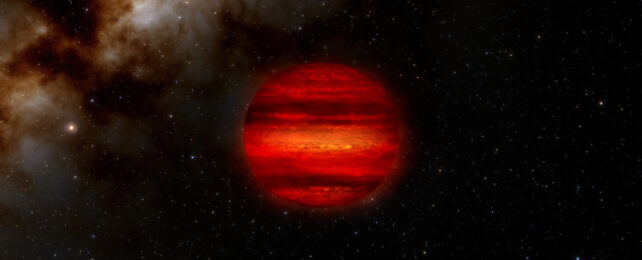We have identified the coldest star ever found to produce radio waves – a brown dwarf too small to be a regular star and too massive to be a planet.
Our findings, published today [July 13] in the Astrophysical Journal Letters, detail the detection of pulsed radio emission from this star, called WISE J0623.
Despite being roughly the same size as Jupiter, this dwarf star has a magnetic field much more powerful than our Sun's. It's joining the ranks of just a small handful of known ultra-cool dwarfs that generate repeating radio bursts.
Making waves with radio stars
With over 100 billion stars in our Milky Way galaxy, it might surprise you astronomers have detected radio waves from fewer than 1,000 of them. One reason is because radio waves and optical light are generated by different physical processes.
Unlike the thermal (heat) radiation coming from the hot outer layer of a star, radio emission is the result of particles called electrons speeding up and interacting with magnetized gas around the star.
Because of this, we can use the radio emission to learn about the atmospheres and magnetic fields of stars, which ultimately could tell us more about the potential for life to survive on any planets that orbit them.
Another factor is the sensitivity of radio telescopes which, historically, could only detect sources that were very bright.
Most of the detections of stars with radio telescopes over the past few decades have been flares from highly active stars or energetic bursts from the interaction of binary (two) star systems. But with the improved sensitivity and coverage of new radio telescopes, we can detect less luminous stars such as cool brown dwarfs.
WISE J0623 has a temperature of around 700 Kelvin. That's equivalent to 420 °C (788 °F) or about the same temperature as a commercial pizza oven – pretty hot by human standards but quite cold for a star.
These cool brown dwarfs can't sustain the levels of atmospheric activity that generates radio emission in hotter stars, making stars like WISE J0623 harder for radio astronomers to find.
How did we find the coolest radio star?
This is where the new Australian SKA Pathfinder radio telescope comes in. This is located at Inyarrimanha Ilgari Bundara, the CSIRO Murchison Radio-astronomy Observatory in Western Australia, and has an array of 36 antennas, each 12 meters in diameter.
The telescope can see large regions of the sky in a single observation and has already surveyed nearly 90 percent of it. From this survey, we have identified close to three million radio sources, most of which are active galactic nuclei – black holes at the centers of distant galaxies.
So how do we tell which of these millions of sources are radio stars? One way is to look for something called "circularly polarized radio emission".
Radio waves, like other electromagnetic radiation, oscillate as they move through space. Circular polarization occurs when the electric field of the wave rotates in a spiraling or corkscrew motion as it propagates.
For our search, we used the fact that the only astronomical objects known to emit a significant fraction of circularly polarized light are stars and pulsars (rotating neutron stars).
By selecting only highly circularly polarised radio sources from an earlier survey of the sky, we found WISE J0623. You can see using the slider in the figure above that once you switch to polarized light, there is only one object visible.
What does this discovery mean?
Was the radio emission from this star some rare one-off event that happened during our 15-minute observation? Or could we detect it again?
Previous research has shown that radio emission detected from other cool brown dwarfs was tied to their magnetic fields and generally repeated at the same rate as the star rotates.
To investigate this, we did follow-up observations with CSIRO's Australian Telescope Compact Array and with the MeerKAT telescope operated by the South African Radio Astronomy Observatory.
These new observations showed that every 1.9 hours, there were two bright, circularly polarized bursts from WISE J0623 followed by a half an hour delay before the next pair of bursts.
WISE J0623 is the coolest brown dwarf detected via radio waves and is the first case of persistent radio pulsations. Using this same search method, we expect future surveys to detect even cooler brown dwarfs.
Studying these missing link dwarf stars will help improve our understanding of stellar evolution and how giant exoplanets (planets in other solar systems) develop magnetic fields.
We acknowledge the Wajarri Yamatji as the traditional owners of the Murchison Radio-astronomy Observatory site where Australian SKA Pathfinder is located, and the Gomeroi people as the traditional owners of the Australian Telescope Compact Array site.![]()
Kovi Rose, Astrophysics PhD Candidate, University of Sydney and Tara Murphy, Professor, University of Sydney
This article is republished from The Conversation under a Creative Commons license. Read the original article.
